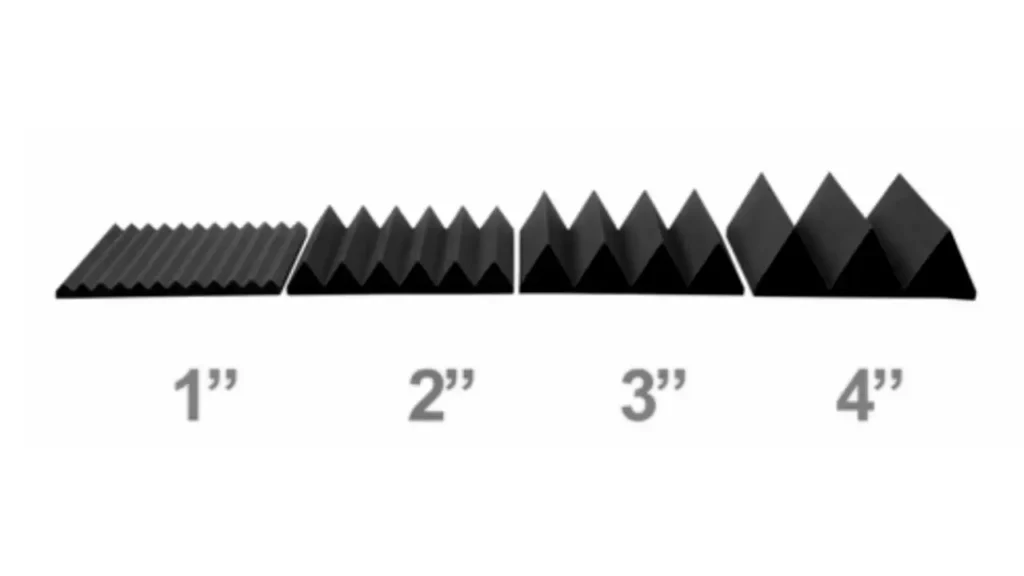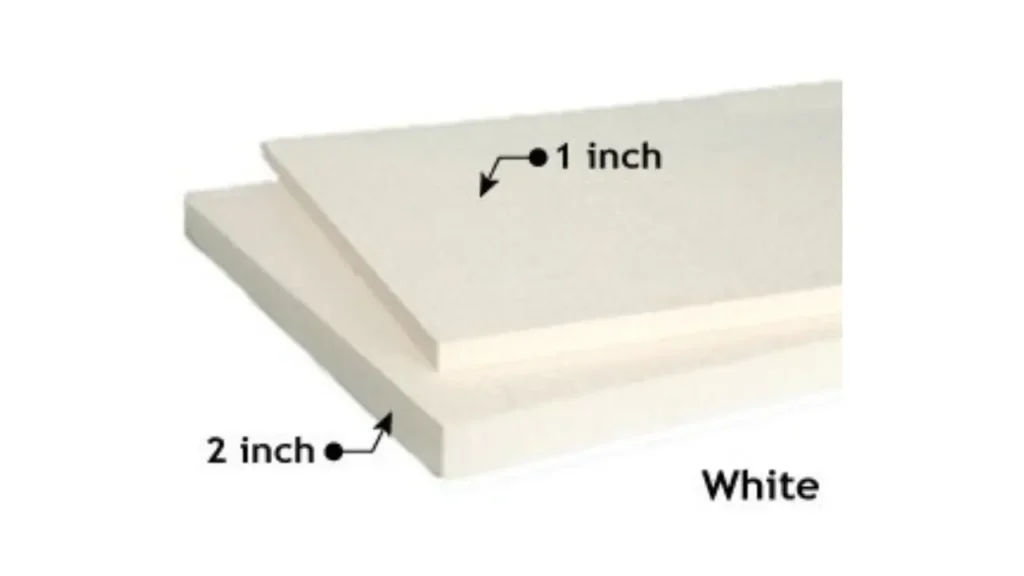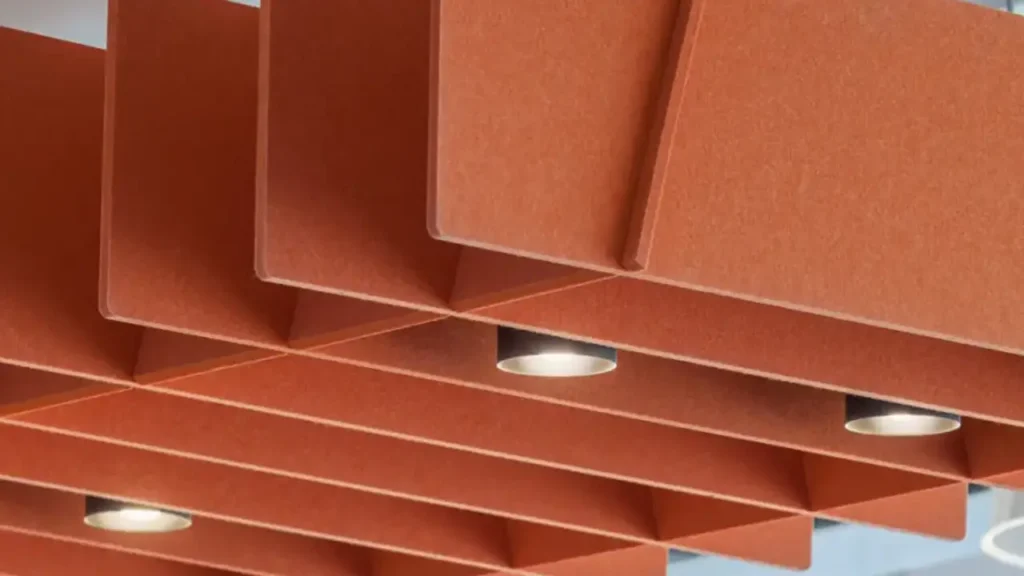Are you looking to improve the acoustics in your home studio, office, or entertainment space? Acoustic panels are a popular solution, but choosing the right thickness can significantly impact their effectiveness.
In this blog post, we’ll explore the factors that influence panel thickness and provide guidelines to help you select the best option for your needs.
How Thick Should Acoustic Panels Be?
The ideal thickness for acoustic panels depends on several factors, including the frequency range you want to target and the size of your space.
General Guidelines:
- 1-inch panels: Effective for mid-to-high frequencies, ideal for treating echo and reverberation in smaller rooms or for speech-focused environments.
- 2-inch panels: Offer better absorption for mid-to-low frequencies, making them suitable for music studios, home theaters, and larger spaces.
- 4-inch panels (bass traps): Designed to absorb low-frequency sounds, essential for controlling bass frequencies in rooms with standing waves.
Factors to Consider:
- Frequency range: Thicker panels are better at absorbing lower frequencies.
- Room size: Larger rooms may require thicker panels to effectively control sound.
- Desired outcome: If you need to address both high and low frequencies, a combination of panel thicknesses might be necessary.
Additional Tips:
- Placement: For maximum effectiveness, place panels on walls and ceilings where sound reflections occur.
- Quantity: The number of panels needed will vary depending on the room’s size and acoustic challenges.
- Density: The density of the acoustic material also affects its absorption capabilities.
By carefully considering these factors, you can choose the optimal thickness for your acoustic panels and create a more enjoyable and balanced listening experience.
Acoustic Panel Thickness

The thickness of acoustic panels is crucial in determining their effectiveness in absorbing sound. Thicker panels generally offer better absorption for lower frequencies, while thinner panels are more suitable for mid-to-high frequencies.
Key Factors to Consider:
- Frequency range: Thicker panels are more effective at absorbing lower frequencies, such as bass. Thinner panels are better suited for mid-to-high frequencies.
- Room size: Larger rooms may require thicker panels to effectively control sound.
- Desired outcome: If you need to address both high and low frequencies, a combination of panel thicknesses might be necessary.
General Guidelines:
- 1-inch panels: Effective for mid-to-high frequencies, ideal for treating echo and reverberation in smaller rooms or speech-focused environments.
- 2-inch panels: Offer better absorption for mid-to-low frequencies, making them suitable for music studios, home theaters, and larger spaces.
- 4-inch panels (bass traps): Designed to absorb low-frequency sounds, essential for controlling bass frequencies in rooms with standing waves.
Remember: The optimal thickness for your acoustic panels will depend on your specific needs and the characteristics of your room. It’s often a good idea to consult with an acoustic professional for personalized advice.
Acoustic Panel Thickness in Millimeters
Acoustic panel thickness is typically measured in inches, but it can also be converted to millimeters. Here’s a quick conversion chart:
| Inches | Millimeters |
|---|---|
| 1 inch | 25.4 mm |
| 2 inches | 50.8 mm |
| 4 inches | 101.6 mm |
So, for example:
- A 1-inch acoustic panel is equivalent to 25.4 mm.
- A 2-inch acoustic panel is equivalent to 50.8 mm.
- A 4-inch bass trap is equivalent to 101.6 mm.
Remember that the optimal thickness for your acoustic panels will depend on your specific needs and the characteristics of your room. Consulting with an acoustic professional can help you determine the best thickness for your situation.
1″ Acoustic Panels vs. 2″ Acoustic Panels

1″ Acoustic Panels are generally suitable for mid-to-high frequency absorption. They are effective at reducing echoes, reverberations, and unwanted noise in smaller spaces like home studios, offices, or bedrooms. These panels are a good choice for improving speech intelligibility and reducing background noise.
2″ Acoustic Panels are designed to absorb mid-to-low frequencies. They are thicker and more dense than 1″ panels, allowing them to control bass frequencies and reduce standing waves effectively. These panels are ideal for larger rooms like home theaters, music studios, or living rooms where deep bass frequencies can be problematic.
Here’s a quick comparison table:
| Feature | 1″ Acoustic Panels | 2″ Acoustic Panels |
|---|---|---|
| Frequency Range | Mid-to-high frequencies | Mid-to-low frequencies |
| Application | Smaller spaces (home studios, offices) | Larger spaces (home theaters, music studios) |
| Effectiveness | Good for reducing echoes and reverberation | Effective at controlling bass frequencies |
1″ acoustic panels are a good option for general noise reduction and improving speech clarity, while 2″ acoustic panels are better suited for controlling bass frequencies and creating a more balanced sound in larger spaces. The best choice for you will depend on your specific needs and the size of your room.
Acoustic Panel Thickness Calculator
I can guide you through a process to determine the appropriate thickness for your acoustic panels based on the factors mentioned earlier.
Factors to Consider:
Frequency Range:
- Low frequencies: Thicker panels (2 inches or more) are generally needed.
- Mid-to-high frequencies: Thinner panels (1 inch) can be sufficient.
Room Size:
- Larger rooms may require thicker panels due to increased reverberation.
- Smaller rooms might benefit from thinner panels.
Desired Outcome:
- If you need to address both high and low frequencies, a combination of panel thicknesses might be necessary.
Online Resources:
While there might not be a specific “acoustic panel thickness calculator,” you can find helpful online resources that can assist you in determining the appropriate thickness:
- Acoustic Treatment Calculators: Some websites offer calculators that can estimate the number and placement of acoustic panels based on your room dimensions.
- Acoustic Consulting Firms: Consulting with an acoustic professional can provide tailored advice based on your specific needs and room characteristics.
Tips for Choosing the Right Acoustic Panels?

When selecting acoustic panels, consider the following factors:
1. Frequency Range:
- Low-frequency absorption: For bass frequencies, opt for thicker panels (2 inches or more).
- Mid-to-high frequency absorption: Thinner panels (1 inch) are generally sufficient.
2. Room Size:
- Larger rooms: Thicker panels may be necessary to control reverberation.
- Smaller rooms: Thinner panels can be effective.
3. Desired Outcome:
- Balanced sound: Consider a combination of panel thicknesses for both high and low frequencies.
- Specific needs: If you have a particular focus (e.g., speech intelligibility, music recording), tailor your panel selection accordingly.
4. Material:
- Density: Denser materials offer better sound absorption.
- Aesthetic: Choose materials that match your interior design (e.g., fabric, wood, fiberglass).
5. Installation:
- Ease of installation: Consider panels with easy-to-use mounting systems.
- DIY-friendly: If you plan to install the panels yourself, look for options with clear instructions.
6. Budget:
- Cost per square foot: Compare prices from different manufacturers and retailers.
- Long-term value: Consider the durability and longevity of the panels.
7. Acoustic Treatment Calculator:
- Online tools: Use calculators to estimate the number and placement of panels based on your room dimensions.
8. Professional Consultation:
- Expert advice: Consult with an acoustic professional for personalized recommendations.
By carefully considering these factors, you can choose the right acoustic panels to improve the sound quality and ambiance of your space.
Conclusion
Choosing the right thickness for your acoustic panels is essential for achieving optimal sound absorption and control. By carefully considering factors like frequency range, room size, and desired outcome, you can select the panels that best meet your needs.
Remember:
- Thicker panels are generally better for low-frequency absorption.
- Thinner panels are suitable for mid-to-high frequencies.
- Larger rooms may require thicker panels.
- Consider a combination of thicknesses for balanced sound control.
Ready to improve the acoustics in your space? Contact us today to explore our wide range of wholesale acoustic panels in various thicknesses and materials. Our experts can help you select the perfect solution for your specific requirements.
